Introduction
When I was growing up in the 1960’s and 70’s in rural Indiana, dreaming big often meant determining how to catch a great guy and marrying him. Yes, settling down and being a “domestic engineer” (otherwise known as a stay-at-home mom) played the major role in the imaginings of young girls. While “mother” has always been and will always be one of the most important roles a girl can pick, we rural Indiana girls didn’t see many other roles modeled for us.
In our town one type of wives/moms was the Catholic professors’ wives/moms whose husbands taught at St. Joseph’s College, such as my own mom. Several of these moms lived in the College Woods, a subdivision a cornfield away from the college. This group of moms reproduced quite regularly and we, their children, thought that the mom with the most children was the winner. You can imagine how my siblings and I felt when Mrs. Jennings took the top spot by cheating and having two sets of twins. She edged out our own mother with nine children to mom’s eight. These moms did a lot of cleaning house, doing laundry, and fixing large meals.
Then there were the farmer’s wives/moms. These women were also often Catholic with large families as well. From what I could tell they were occupied with even more manual labor than the professors’ wives since they also helped with the daily grind of farm work. The town moms who weren’t Catholic seemed to have it a bit better because they had fewer children under their wings. The single moms who worked as school secretaries seemed to do okay as well, but the women teachers were my favorite. Why? In my mind quality of life was based on how much manual labor a person had to do, and I thought the teachers were making out like bandits within this rating system. My main goal: not to become a farmer’s wife.
I never even knew there were jobs in technology and that women could work in such jobs. I did take a computer class my senior year of high school in 1979. I learned Fortran and I got to work with the room-size computer at St. Joseph’s College in order to see how my “program” ran. This class I saw as a “hobby” and not as something I would ever do for work.
“Girls on the Move”
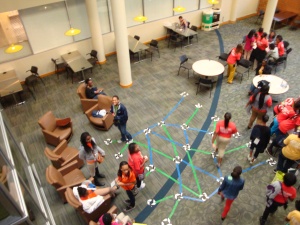
On November 1, 2013, I had the honor of helping today’s girls dream big. Southern Polytechnic State University’s Chapter of the Society of Women Engineers (SWE) hosted “Girls on the Move,” an event that introduced over 50 middle school girls involved in the YWCA’s Teenage Girls in Technology (TGI Tech) group to Science, Technology, Engineering, and Math (STEM) related fields of study.
Vickie Moody, the sponsor of SWE at SPSU worked with SWE members Crystal Matheny and Victoria Knox to lead the creation of the event, the second such event that SWE has held for TGI Tech girls.
I’m still not completely sure how Crystal pulled me in to help with the event, but I do know that the information she sent me helped me to determine that I should get involved. Crystal’s materials showed me just how thoughtful she had already been about trying to get SWE to lkkhost this event. Crystal had built upon the relationship she had already created with TGI Tech, and she had begun the process of writing a grant request of Women in Technology (WIT) for funding Girls on the Move (WIT later awarded SWE with a $1,500 grant for the event).
Crystal is a go-getter. This past summer she took part in an internship in California with Hewlett Packard (HP). Her ideas for Girls on the Move began to percolate at this time. She was put in touch with Peggy Amend who works as a Converged Systems Engineering Operations Manager at HP here in Atlanta. Peggy also chairs the HP volunteer team. She helped Crystal pull together a crew of volunteers. By the time Crystal had completed rounding up people to help, the Chattahoochee Riverkeeper, Georgia Power, the Black Data Processing Associates (BDPA), SPSU recruiters and professors had all signed up to help.
Judy Fears, the Director of Youth Services for the YWCA of Greater Atlanta Afterschool Programs, TGI Tech, and the After School Learning Academy, worked with several local middle schools to bring the girls to campus. Judy believes that middle school is a critical period in the lives of girls as they begin to imagine their futures and to determine their strengths and weaknesses. She tries to share her love and knowledge of technology with these young girls who are often from underrepresented communities.
“Girls on the Move” opened with a talk by Ms. Stephanie Coleman, SPSU’s Director of Web Services and finalist for the 2013 Woman of the Year in Technology Award presented by the Georgia-based organization Women in Technology (WIT) concerning opportunities in Technology. The girls later got a chance to visit booths and talk with volunteers from SPSU and the various companies and organizations taking part in “Girls on the Move.” In the afternoon SWE members Victoria Knox, Tamara Franklin, and Valerie Washington led the girls through a number of hands-on learning activities about engineering. The day ended with “gifts” for the girls from SPSU and HP. The event was an interactive success for the girls.
Vickie’s and Crystal’s Stories
I am always curious about what drives people to give back and to act as role models for those who are interested in following them. Thus, I wanted to know about the two SPSU women who spearheaded this effort: Vickie Moody and Crystal Matheny.
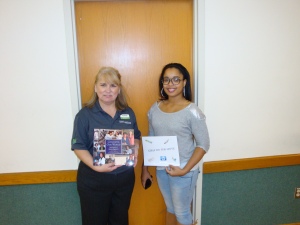
Vickie
Vickie would not have ended up at SPSU if corporate downsizing at her place of work had not wiped out its Atlanta Office. Vickie took this change in her life as an opportunity to go to college, the first in her family to do so. She attended Kennesaw State University and graduated Summa Cum Laude with a degree in Middle Grades Education. Her plans to become a teacher were interrupted when she took what she thought would be a temporary job at SPSU as an administrative assistant. Instead she ended up staying at SPSU for the past ten years. She currently works in the Mechanical Engineering Technology office. Becoming the advisor for SWE came “natural” to her. Vickie, who was an employee of the year in her corporate life, had also been a member of a professional women’s organization that mentored high school girls. Because Vickie acts as a role model and as an “unofficial” mom to students, it’s not surprising that the women involved with SWE asked her to be their advisor. It’s also not surprising that Crystal turned to Vickie to help her with this project.
Crystal
Crystal, like Vickie, took an event in her life that could have dashed her dreams and found a way to power through it—helping girls do likewise is now part of her dream. While she was a junior in high school she became pregnant with her daughter. Mr. Eric Ritenour, her Advanced Placement (AP) Calculus teacher at Southwest Dekalb High School, encouraged her to continue her studies. Ritenour had graduated from Georgia Tech and had worked as a mechanical engineer before becoming a physics and mathematics teacher. He helped Crystal to decide that she should still take the AP Calculus exam and that she should still apply to colleges.
Crystal did as he suggested. She passed the AP Calculus test (one of only three people in her class to do so), and she was given a full scholarship to Georgia State University. Realizing that she wanted a STEM background, she transferred to Georgia Perimeter College, she worked at T-Mobile as a sales representative, and ended up at SPSU studying electrical engineering. She was recently hired by HP and began working with the company shortly before the “Girls on the Move” event.
It was while she was at GPC that she became familiar with YWCA’s TGI Tech. She took part in a work-study program with the group and she soon became “addicted” to working with the girls. When she realized that SWE provided emotional support for women students, she joined the organization and knew that this group of women would be a great influence on the girls in TGI Tech. It is Crystal who has helped bring these two organizations together.
The Achievement/Problem-Solving Theme
While I wasn’t able to talk with all of the wonderful people who had volunteered to help for “Girls on the Move,” I was able to talk with enough of them to see a theme building that weaved its way through their stories. Like Vickie and Crystal, the volunteers were willing to see opportunities, were willing to grow through these opportunities, were willing to use their talents to problem solve, and were willing to give back to others.
BDPA
Felicia Jones and Teresa Williams, who represented the Atlanta Chapter of BDPA for “Girls on the Moves,” shared their stories with me. Their stories showed quite well the ways in which women can take advantage of opportunities so that they can then give back to the girls following them.
Felicia
Felicia told me that BDPA has provided her with the opportunity to mentor others and to be mentored herself. She likes keeping abreast on the latest news concerning the Information Technology professional. Sharing information with young girls about the need for learning to communicate properly so that they can represent themselves and their companies well is important to Felicia.
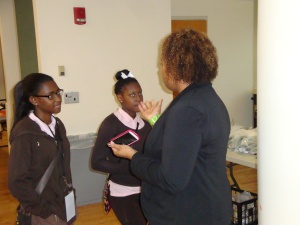
Felicia has worked at Macy’s for the last thirteen years as a Manager at Systems and Technology. It is her job to ensure that applications and devices are working correctly for Macy’s. Felicia got her start in the IT world well before three-year-olds became capable of using technology. She was working at the Southeast regional veterans’ personnel office when she got involved in creating queues that later had to be destroyed. She was getting through her work so quickly that she was bored. The next thing she knew, she was taking an aptitude test for a 6-month programming language program. Felicia found that she did have a strong aptitude and that she liked getting the immediate feedback that she received when a program did or didn’t work.
Felicia ended our talk by discussing one of the young girls she talked to while at “Girls on the Move” who was simply beaming with the excitement of getting an opportunity to do something more than what her family members are able to do. It is these girls who she considers “diamonds in the rough” that she wants to take home with her so that she can do everything possible to pass on what she knows.
Teresa
I found out that Teresa, who is the South Regional Vice President for BDPA likewise fell into programming. At the time she was working in Des Moines, Iowa for Monsanto. Her boss needed the administrative support staff to learn and to use technology in the office and so he was willing to train her on the job in Fortran. She found that programming worked with her natural strengths as a woman to multi-task, to problem solve, and to ensure that everything came out at the same time. Teresa realized that she had a high aptitude in design, and she now works as a Program Manager in Membership and Billing for NASCO—a company associated with Blue Cross Blue Shield.
Teresa’s goal is to help bring more women into the STEM fields. She wants to help girls as they transition from high school to college in order to achieve her goal.
HP
I also got the chance to talk with the following people from HP: Peggy Amend, who worked tirelessly to help the women of SWE put the event together; Dawn Woolcock, a Mission Critical Services Delivery Manager for the Global Customer Experience-Americas Group; and Nicole Amedee-Jefferson, an operational support engineer.
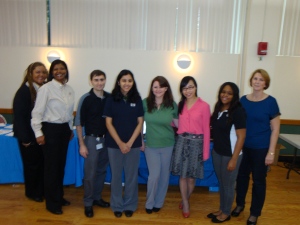
Peggy
Peggy, who chairs HP’s local volunteer team, was “sucked” in by Crystal to assist with “Girls on the Move.” She told me that HP Corporate loves anybody with an idea. Peggy has been with HP for eighteen years and finds that the service outreach performed by the company is what creates a sense of family in this large corporation. One of the first things she did at HP after the small company for which she worked was bought out by HP was to volunteer at an outreach event. She soon found that she loved this part of the corporation.
Peggy started out in electrical engineering but became really interested in computer science when she took an elective course in the field and realized that through Tele-typing for a simplistic game that she could make something across town move. She told me that she found out that you never know what you’re going to end up doing so you should get involved with everything possible.
Dawn
Dawn has also been with HP for eighteen years and she currently manages a team of 22 engineers in order to support servers and operation systems for HP’s custom mission critical accounts. Dawn began her problem solving early in her life. She liked to understand exactly how things worked. She liked tying her shoes, making knots, and taking things apart and putting them together again. After Dawn worked a math problem, she liked to do the problem backwards to see if she would arrive at the original question.
Dawn reminds me of many of the engineering students I’ve taught at SPSU because they, too, like absolute answers more than relative ones. What Dawn likes about engineering is that one can solve a problem and experience instant gratification. As a manager she must often wait for two or three months to see if things work out—she’s part of a system of problem solving in this case.
Nicole
Nicole enjoys seeing the big picture and understanding how the parts fit the big picture. She has been with HP for 21 years and is currently an operational support engineer. She was originally interested in merchandizing when she attended college, but she soon realized that she likes to “fix” things. At HP she enjoys ensuring that the engineers have what they need to succeed. She is focused on quality and what drives processes and people.
Lindsey Foster, Ramya Bommareddy, Daniel Church, Yichen Feng, and Takeena Cochren made up the rest of the HP team who were helping the girls.
The Chattahoochee Riverkeeper
I was only able to talk a short while with the volunteers from the Chattahoochee Riverkeeper (CRK); however, Jessica Sterling and Cody Smith were able to tell me a bit about the mission and history of CRK. According to Jessica, who is a Watershed Protection Specialist, CRK was established in the mid-1990s in order to restore and to preserve the ecological health of the Chattahoochee River, its estuaries, and its basin. Jessica told me that they had indeed managed to restore quite a bit of the river’s health in the past 10 years or so. Given that the river is a
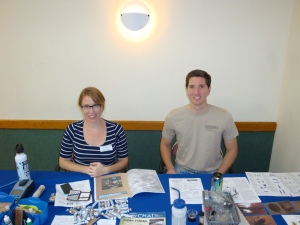
drinking water source for nearly 4 million Georgians as well as for the wildlife surrounding the river, the importance of what the CRK does cannot be overstated.
One of the missions of the CRK is to educate the public and we got to see Jessica and Cody in action as they talked with the girls about their backgrounds and their mission. According to Jessica’s biography at the website for the CRK, she graduated from Ohio University in 2003 and continued her education at the Odum School of Ecology at the University of Georgia, graduating in 2012.
Georgia Power
Georgia Power brought an interactive power setup called PowerTOWN that was quite the hit with the students. The three representatives used PowerTOWN to demonstrate real-life scenarios involving the use of electricity. The girls got the chance to understand how to use electricity safely.
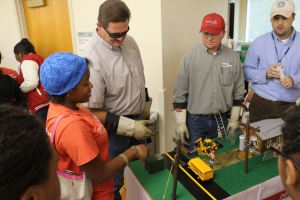
SPSU Representatives
Two faculty members, Dr. Hoseon Lee, a new faculty member who teaches Electro-magnetics, and Dr. Lori Lowder, a new faculty member in Systems & Mechanical Engineering were sponsors of a booth. They helped girls to understand the type of educational background the girls would need to become an engineer. Elizabeth Fokes, a graduate student in Information Technology also volunteered as well as Rebecca Tuck and Chelsea Ferraco from the Recruitment Office who helped the girls learn more about how to become a college student.
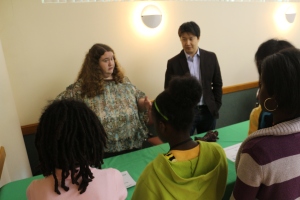
Conclusion
In the end I wanted to circle back to my own mother, the domestic engineer, and what she has in common with the volunteers, several of whom are engineers in the corporate world. Mom, like many of these women, is a problem solver—one has to be in a household of ten people. She created an organizational system, which meant that her troops (otherwise known as her children) had to master certain tasks in order to keep the house running properly. My mother loved to host a good party and would invite members of her large family (she grew up with eleven siblings) to our home. In order to pull off such a large gathering, my mom would prepare dishes days in advance (with the help of her troops, of course) and would freeze the food. All she would later have to do to make things work was to heat it up for dinner.
My mom and dad did raise us to dream big, even in rural Indiana. Seven of us have graduated from college and six of us have earned a master’s degree: In that final grouping are all four of her girls.